headlamp Citroen C5 RHD 2015 (RD/TD) / 2.G Owner's Manual
[x] Cancel search | Manufacturer: CITROEN, Model Year: 2015, Model line: C5 RHD, Model: Citroen C5 RHD 2015 (RD/TD) / 2.GPages: 362, PDF Size: 32.4 MB
Page 5 of 362
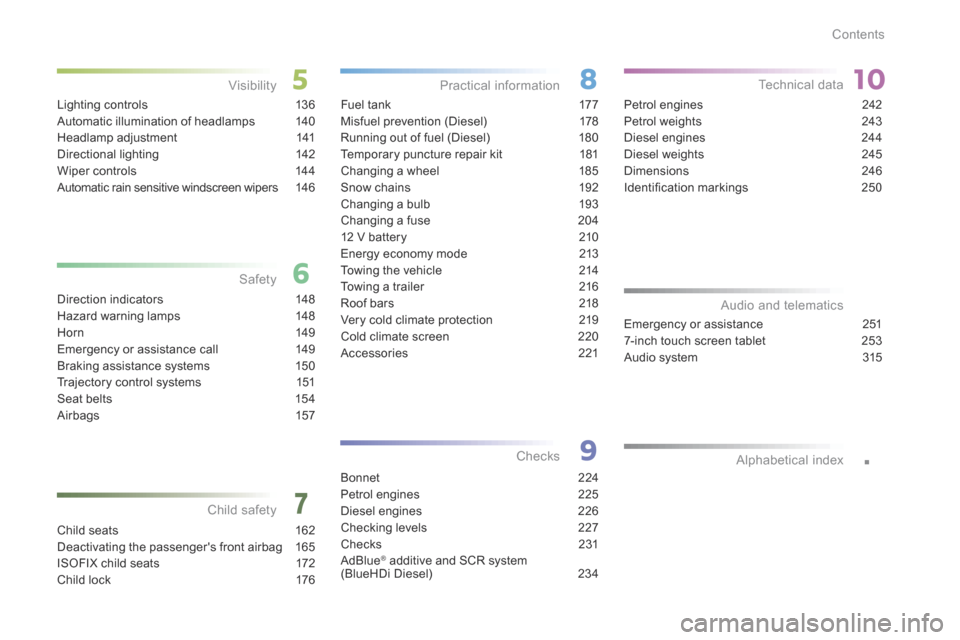
.
Direction indicators 148
Hazard warning lamps 148
Hor n 149
Emergency or assistance call 149
Braking assistance systems 150
Trajectory control systems 151
Seat belts 154
Airbags 157Fuel tank
177
Misfuel prevention (Diesel) 178
Running out of fuel (Diesel) 180
Temporary puncture repair kit 181
Changing a wheel 185
Snow chains 192
Changing a bulb 193
Changing a fuse 204
12 V battery 210
Energy economy mode 213
Towing the vehicle 214
Towing a trailer 216
Roof bars 218
Very cold climate protection 219
Cold climate screen 220
Accessories 221
Bonnet 224
Petrol engines 225
Diesel engines 226
Checking levels 227
Checks 231
AdBlue
® additive and SCR system
(BlueHDi Diesel) 234Petrol engines
242
Petrol weights 243
Diesel engines 244
Diesel weights 245
Dimensions 246
Identification markings 250
Emergency or assistance 251
7-inch touch screen tablet 253
Audio system 315
Audio and telematics
Lighting controls 136
Automatic illumination of headlamps 140
Headlamp adjustment 141
Directional lighting 142
Wiper controls 144
Automatic rain sensitive windscreen wipers 14 6
Alphabetical index
Child safety Practical information
Checks
Visibility
Safety Technical data
Child seats
162
Deactivating the passenger's front airbag 165
ISOFIX child seats 172
Child lock 176
Contents
Page 6 of 362
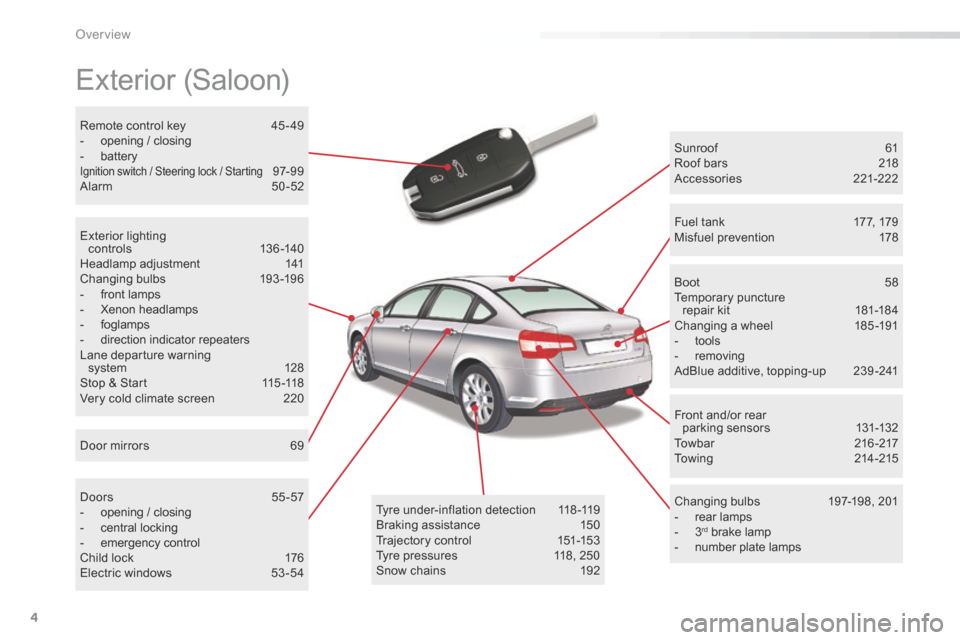
4
Exterior (Saloon)
Sunroof 61
Roof bars 218
Accessories 221-222
Changing bulbs 197-198, 201
- rear lamps
- 3
rd brake lamp
- number plate lamps
Boot
58
Temporary puncture
repair kit 181-184
Changing a wheel 185 -191
- tools
- removing
AdBlue additive, topping-up 239 -241
Tyre under-inflation detection 118 -119
Braking assistance 150
Trajectory control 151-153
Tyre pressures 118, 250
Snow chains 192Fuel tank
177, 179
Misfuel prevention 178
Remote control key
45 - 49
- opening / closing
- battery
Ignition switch / Steering lock / Starting 97- 9 9
Alarm 50-52
Door mirrors 69
Exterior lighting
c o nt r o ls 13 6 -14 0
Headlamp adjustment 141
Changing bulbs 193-196
- front lamps
- Xenon headlamps
- foglamps
- direction indicator repeaters
Lane departure warning system 128
Stop & Start 115 -118
Very cold climate screen 220
Doors 55 -57
- opening / closing
- central locking
- emergency control
Child lock 176
Electric windows 53 -54 Front and/or rear
parking sensors 131-132
Towbar 216 -217
Towing 214 -215
over view
Page 7 of 362
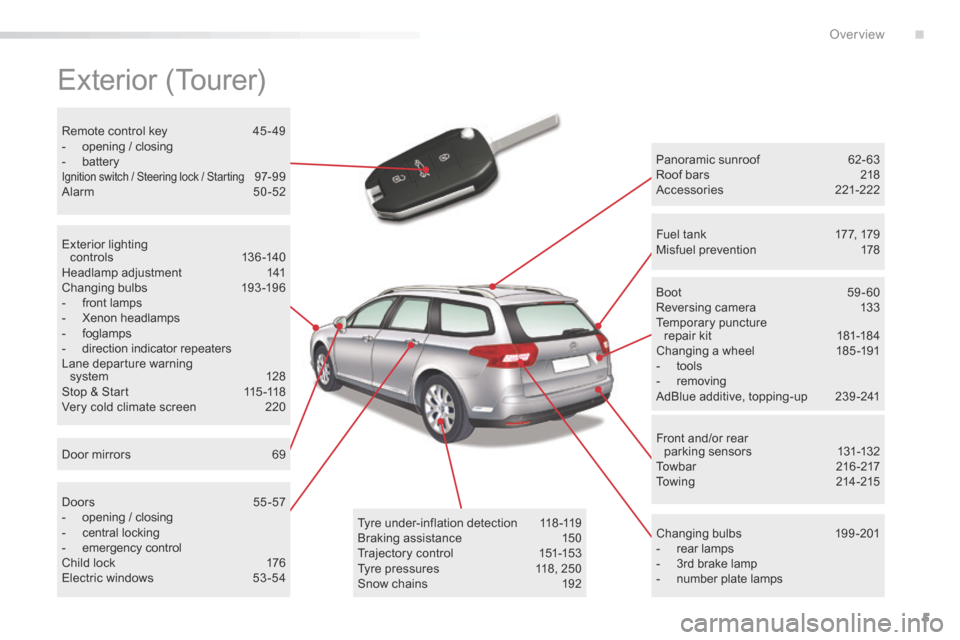
5
Exterior (Tourer)
Panoramic sunroof 62- 63
Roof bars 218
Accessories 221-222
Changing bulbs 199-201
- rear lamps
- 3rd brake lamp
- number plate lamps
Boot
59-60
Reversing camera 133
Temporary puncture
repair kit 181-184
Changing a wheel 185 -191
- tools
- removing
AdBlue additive, topping-up 239 -241
Tyre under-inflation detection 118 -119
Braking assistance 150
Trajectory control 151-153
Tyre pressures 118, 250
Snow chains 192
Remote control key
45 - 49
- opening / closing
- battery
Ignition switch / Steering lock / Starting 97- 9 9
Alarm 50-52
Fuel tank 177, 179
Misfuel prevention 178
Door mirrors 69
Exterior lighting
c o nt r o ls 13 6 -14 0
Headlamp adjustment 141
Changing bulbs 193-196
- front lamps
- Xenon headlamps
- foglamps
- direction indicator repeaters
Lane departure warning system 128
Stop & Start 115 -118
Very cold climate screen 220
Doors 55 -57
- opening / closing
- central locking
- emergency control
Child lock 176
Electric windows 53 -54 Front and/or rear
parking sensors 131-132
Towbar 216 -217
Towing 214 -215
.
over view
Page 12 of 362
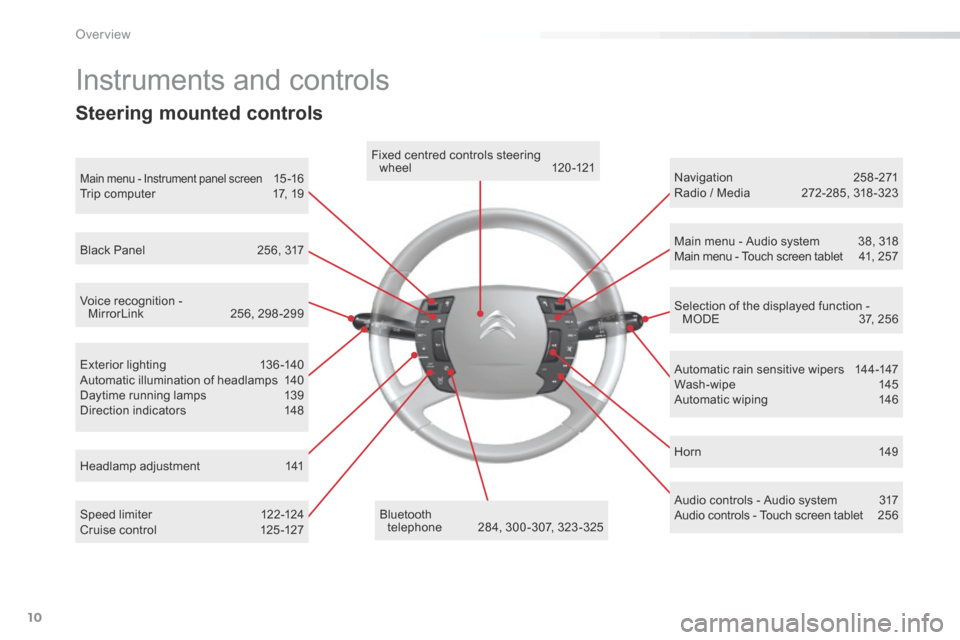
10
Exterior lighting 136-140
Automatic illumination of headlamps 140
Daytime running lamps 139
Direction indicators 148
Instruments and controls
Speed limiter 122-124
Cruise control 125 -127 Automatic rain sensitive wipers
144-147
Wash-wipe 145
Automatic wiping 146
Headlamp adjustment 141
Main menu - Instrument panel screen 15 -16
Trip computer 17, 19Fixed centred controls steering
wheel 120 -121
bluetooth telephone 284, 300 -307, 323 -325 Hor n
149
Navigation
258-271
Radio / Media 272-285, 318 -323
Selection of the displayed function - MODE 37, 256
Main menu - Audio system
38, 318
Main menu - Touch screen tablet 41, 257
Voice recognition - MirrorLink 256, 298 -299
Black Panel
256, 317
Audio controls - Audio system 317
Audio controls - Touch screen tablet 256
Steering mounted controls
over view
Page 13 of 362
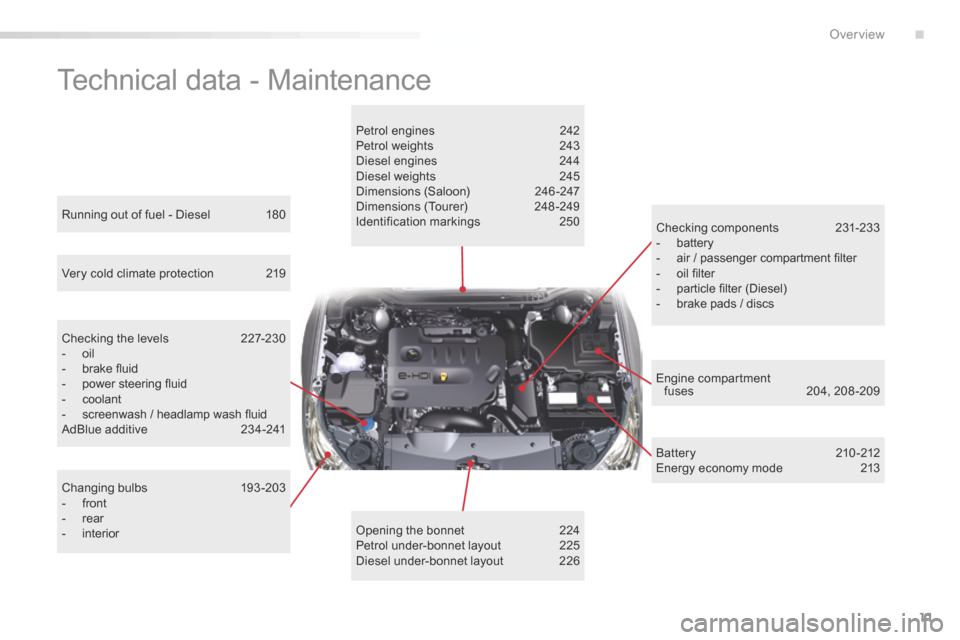
11
Technical data - Maintenance
Petrol engines 242
Petrol weights 243
Diesel engines 244
Diesel weights 245
Dimensions (Saloon) 246-247
Dimensions (Tourer) 248 -249
Identification markings 250
Opening the bonnet 224
Petrol under-bonnet layout 225
Diesel under-bonnet layout 226
Running out of fuel - Diesel
180
Checking the levels 227-230
- oil
- brake fluid
- power steering fluid
- coolant
- screenwash / headlamp wash fluid
AdBlue additive 234-241
Very cold climate protection
219
Changing bulbs 193-203
- front
- rear
- interior Checking components
231-233
- battery
- air / passenger compartment filter
- oil filter
- particle filter (Diesel)
- brake pads / discs
Batter y 210 -212
Energy economy mode 213
Engine compartment
fuses 204, 208 -209
.
over view
Page 14 of 362
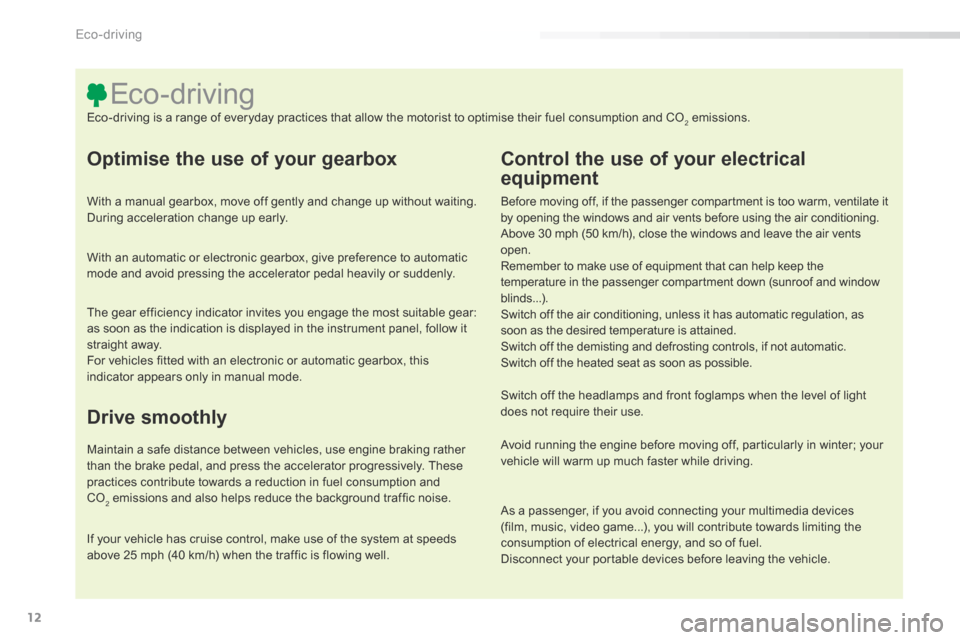
12
Optimise the use of your gearbox
With a manual gearbox, move off gently and change up without waiting.
During acceleration change up early.
With an automatic or electronic gearbox, give preference to automatic
mode and avoid pressing the accelerator pedal heavily or suddenly.
Control the use of your electrical
equipment
Before moving off, if the passenger compartment is too warm, ventilate it
by opening the windows and air vents before using the air conditioning.
Above 30 mph (50 km/h), close the windows and leave the air vents
open.
Remember to make use of equipment that can help keep the
temperature in the passenger compartment down (sunroof and window
blinds...).
Switch off the air conditioning, unless it has automatic regulation, as
soon as the desired temperature is attained.
Switch off the demisting and defrosting controls, if not automatic.
Switch off the heated seat as soon as possible.
Switch off the headlamps and front foglamps when the level of light
does not require their use.
Avoid running the engine before moving off, particularly in winter; your
vehicle will warm up much faster while driving.
As a passenger, if you avoid connecting your multimedia devices
(film, music, video game...), you will contribute towards limiting the
consumption of electrical energy, and so of fuel.
Disconnect your portable devices before leaving the vehicle.
Eco-driving
Eco-driving is a range of everyday practices that allow the motorist to optimise their fuel consumption and CO2 emissions.
The gear efficiency indicator invites you engage the most suitable gear:
as soon as the indication is displayed in the instrument panel, follow it
straight away.
For vehicles fitted with an electronic or automatic gearbox, this
indicator appears only in manual mode.
Drive smoothly
Maintain a safe distance between vehicles, use engine braking rather
than the brake pedal, and press the accelerator progressively. These
practices contribute towards a reduction in fuel consumption and
Co
2 emissions and also helps reduce the background traffic noise.
If your vehicle has cruise control, make use of the system at speeds
above 25 mph (40 km/h) when the traffic is flowing well.
Eco-driving
Page 18 of 362
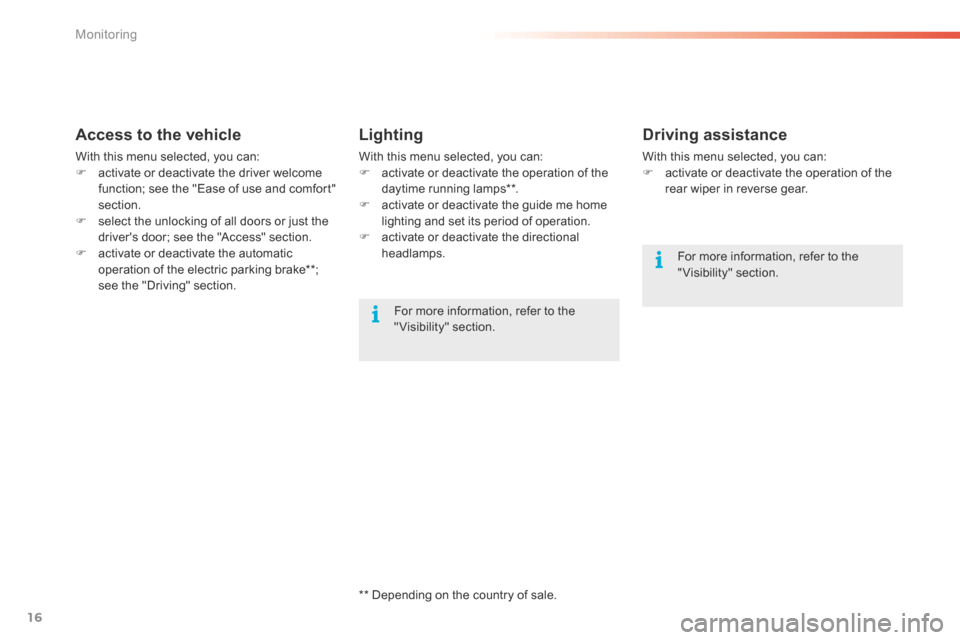
16
Access to the vehicle
With this menu selected, you can:
F activate or deactivate the driver welcome
function; see the "Ease of use and comfort"
section.
F select the unlocking of all doors or just the
driver's door; see the "Access" section.
F activate or deactivate the automatic
operation of the electric parking brake**;
see the "Driving" section.
Lighting
With this menu selected, you can:
F activate or deactivate the operation of the
daytime running lamps**.
F activate or deactivate the guide me home
lighting and set its period of operation.
F activate or deactivate the directional
headlamps.
Driving assistance
With this menu selected, you can:
F activate or deactivate the operation of the
rear wiper in reverse gear.
For more information, refer to the
"Visibility" section. For more information, refer to the
"Visibility" section.
** Depending on the country of sale.
Monitoring
Page 36 of 362
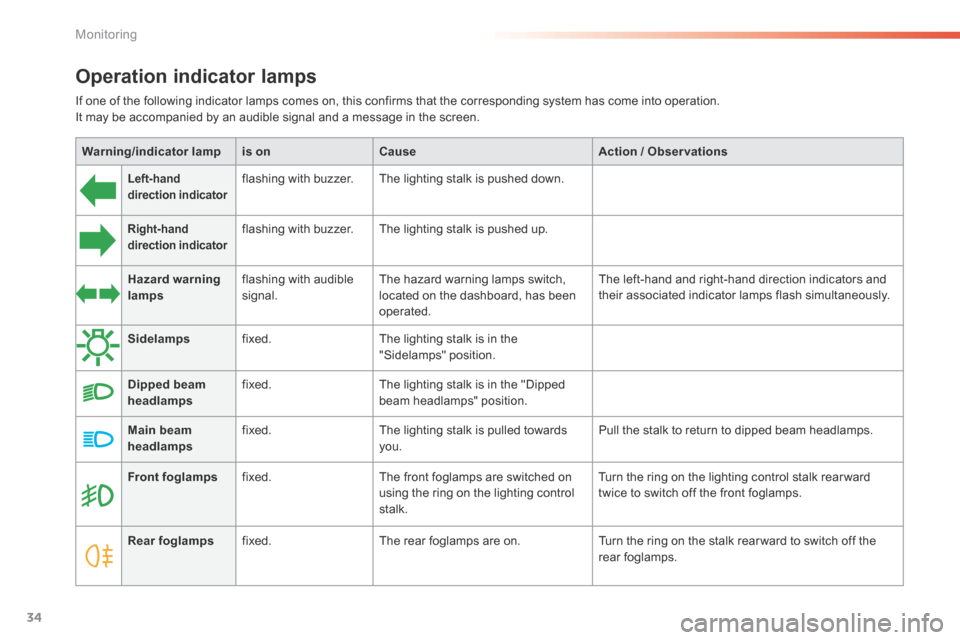
34
Front foglampsfixed. The front foglamps are switched on
using the ring on the lighting control
stalk. Turn the ring on the lighting control stalk rear ward
twice to switch off the front foglamps.
Rear foglamps fixed. The rear foglamps are on. Turn the ring on the stalk rear ward to switch off the
rear foglamps.
Operation indicator lamps
Warning/indicator lampis on Cause Action / Observations
Left-hand
direction indicatorflashing with buzzer. The lighting stalk is pushed down.
Right-hand
direction indicatorflashing with buzzer.The lighting stalk is pushed up.
Sidelamps fixed. The lighting stalk is in the
"Sidelamps" position.
Dipped beam
headlamps fixed.
The lighting stalk is in the "Dipped
beam headlamps" position.
Main beam
headlamps fixed.
The lighting stalk is pulled towards
you. Pull the stalk to return to dipped beam headlamps.
Hazard warning
lamps
flashing with audible
signal. The hazard warning lamps switch,
located on the dashboard, has been
operated. The left-hand and right-hand direction indicators and
their associated indicator lamps flash simultaneously.
If one of the following indicator lamps comes on, this confirms that the corresponding system has come into operation.
It may be accompanied by an audible signal and a message in the screen.
Monitoring
Page 72 of 362

70
Automatic day/night model
In order to guarantee optimum visibility
during your manoeuvres, the mirror lightens
automatically when reverse gear is engaged. By means of a sensor, which measures the
light from the rear of the vehicle, this system
automatically and progressively changes
between the day and night uses.
It has an anti-dazzle system which darkens the
mirror glass: this reduces any driver discomfort
caused by the light beam of following vehicles,
the sun...In vehicles fitted with electrochromatic door
mirrors, the system has an on/off button and an
associated warning lamp.
On
F
With the ignition on, press on button 1 .
The warning lamp 2 comes on and the mirror
glass is in automatic mode.
Off
F Press on button 1 .
The warning lamp 2 goes off and the mirror
glass remains in its lightest definition.
Rear view mirror
Manual day/night model
Adjustment
F Adjust the mirror so that the glass is
directed correctly in the "day" position.
Day / night position
F Pull the lever to change to the "night" anti-
dazzle position.
F Push the lever to change to the normal
"day" position.
Adjustable mirror providing a central rear ward view.
Equipped with an anti-dazzle system, which darkens the mirror glass and reduces the nuisance to
the driver caused by the sun, headlamps from other vehicles...
Ease of use and comfort
Page 86 of 362
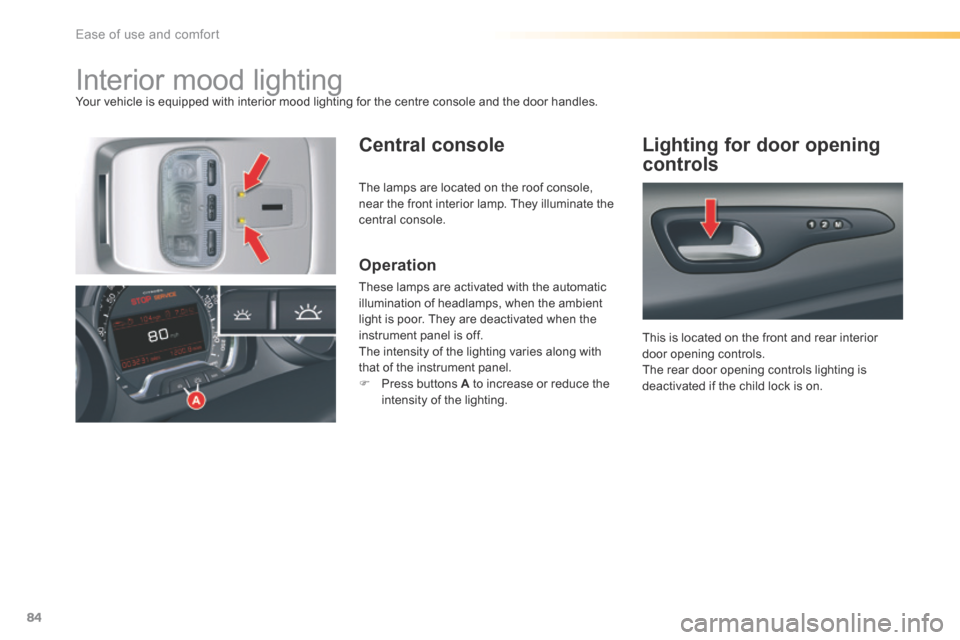
84
Interior mood lightingYour vehicle is equipped with interior mood lighting for the centre console and the door handles.
Central consoleLighting for door opening
controls
Operation
These lamps are activated with the automatic
illumination of headlamps, when the ambient
light is poor. They are deactivated when the
instrument panel is off.
The intensity of the lighting varies along with
that of the instrument panel.
F Press buttons A to increase or reduce the
intensity of the lighting. This is located on the front and rear interior
door opening controls.
The rear door opening controls lighting is
deactivated if the child lock is on.
The lamps are located on the roof console,
near the front interior lamp. They illuminate the
central console.
Ease of use and comfort